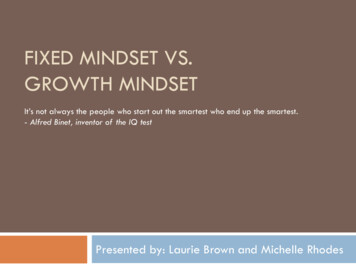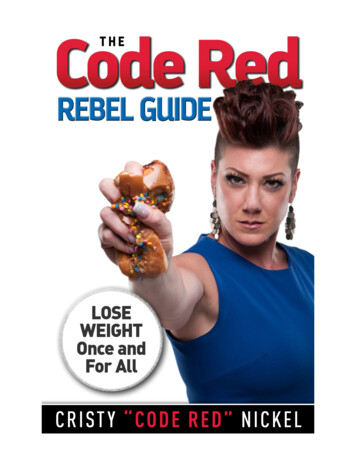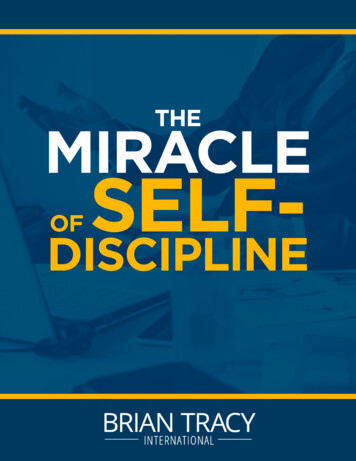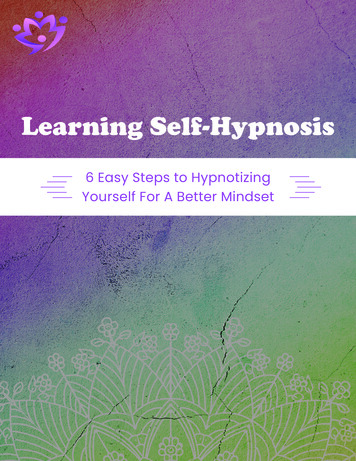
Transcription
Self-belief: how to believe in you!By Dr Cate Howell
IntroductionMost days of the week I speak with clientsat my counselling practice, and a commontheme is a ‘low self-esteem’ with many selfdoubts. When I train health professionalsabout mental health or about teaching, oftenthe same sense of self-doubt comes into play.Have you had the experience of thoughtsabout not being ‘good-enough’ coming intothe mind and undermining your confidence.Equally for new Mums, or those startinga business, those thoughts can be a hugeproblem. This e-book is all about dealingwith those self-doubts and developingyour self-belief, so that you can feel moreconfident and achieve what you want tofor yourself.What lies behind usand what lies beforeus are tiny matterscompared to what lieswithin us. ‒ Ralph Waldo Emerson
DefinitionsLet’s first define some commonly used terms: Self-esteem refers to how you see and judgeyourself, often in comparison to others. Itdescribes your opinion of yourself and sense ofself-worth. Self-esteem affects how you function generallyand how you relate to other people. It includesself-confidence or how confident you feel aboutyour abilities (Howell, 2010, p 80). Underlying beliefs about yourself, whenconstructive, are referred to as self-belief, andthese drive your thinking about yourself andhow confident you feel. A more recent term is self-compassion, whichmeans that you are kind and understandingtowards yourself when faced by your personalfailings, instead of criticising and judgingyourself harshly (Neff, 2003, p86).In this e-book I will mostly utilise the termsself-belief and self-compassion.What influencesself-belief?From the moment we are born, there are arange of influences on our self-belief, andthese include:1. Your early life experiences.A child who experiences a lot of criticismgrowing up, for example, will struggle todevelop a strong sense of self-belief. We maytake on the belief that we are not ‘good enough’or that we don’t achieve what is expected of us.2. The society in which we live.We are all in some way influenced by the media,culture, government, religion and education,and these influences may be positive ornegative. Women, for example, may take on theview that to be worthy, they must be attractive,nurturing, smart, successful and more! Menmay take on the idea that they must havecertain attributes too such as being strong andsuccessful. These views tend to be unrealisticand can lead to us putting pressure on ourselvesthrough comparison with an unrealistic ideal.3. Being human.As humans we tend to compare to others. Thisis actually a survival mechanism, but in themodern age, the comparisons tend to be withpeople around us, including people showcasedby the media. Remember that what we see ofthese individuals is just a snap-shot of theirlives, and we in face know very little aboutthem. In addition, we live in a world in whichsuccess is often defined by material possessions,and this can be another comparison trap.4. Ongoing life experiences.Experiences in families, relationships or in theworkplace continue to influence your self-belief.If we come across a bully or an abusive person,their negative and intimidating behaviours canimpact on our self-belief. Compare these peopleto encouraging individuals who boost self-belief.
What influencesself-belief? cont.5. Our personality and thinking style. Perfectionism can drive us to highexpectations of ourselves, and a sense ofnot doing well enough if not meeting thoseexpectations. It is hard to have a strong senseof self-belief if those expectations are gettingin the way. Equally, a sense of wanting toplease and looking for approval from others,can challenge our self-belief. Are you and optimistic thinker? Optimisticthinking can help us focus on positive eventsin life and our own positive attributes.Negative thinking about ourselves andwhat we can achieve can contribute to lowself-confidence. Sometimes negative or perfectionisticthinking can be ‘black and white’ i.e. ‘thatwent really, really well’, or ‘it went really,really badly’, rather than seeing possibilitiesin between.How does low self-beliefinfluence our healthand wellbeing?Low self-belief can affect our health andwellbeing in many ways, such as:1. Contributing to stress, anxiety and low mood.2. In turn these may affect our sleep and eatinghabits, or ability to exercise, and thus ourgeneral health.3. It can be tiring and distracting to focus onour limitations, and low self-belief can affectour coping behaviours e.g. engaging in leisureactivities.4. Affecting our confidence with others, andpreventing us from going out socially or goingto work functions.5. It may affect assertiveness with others, or causeus to not put ourselves forward for tasks atwork through fear of failing.So positive self-belief is protective for ourphysical and mental health!
Ways to improveself-belief!1. Change our thinking.We have thoughts, feelings and behaviours,and these three are all inter-related. This isthe basis of Cognitive Behaviour Therapy(CBT). Our thoughts influence how we feel,and vice versa, and our behaviours affect howwe think and feel, and vice versa! To feel oract more confidently, sometimes we needto work on our thinking. In addition, ourthoughts reflect our underlying unconsciousbeliefs about ourselves.It is worth being aware of some of theunderlying beliefs that can rob you of selfbelief, and these include: I must keep proving myself throughmy achievements. I must do things perfectly. I must have everyone’s approval. I need to be loved to be worthwhile. The world must be fair and just (Tanner andBall, 2001).It is helpful to realise that: Our worth is not actually about what weachieve. Achievements give a sense ofsatisfaction, but not true self-belief, and involvefocusing on the future rather than the present. Perfectionism is sometimes helpful, but notalways helpful, and can lead to anxietyand disappointment. We all seek approval from others, but you haveto be careful not to measure your sense of worthbased on the expectations or the praise of others.What is really important is what you thinkabout yourself, whether you accept yourself andwhat you do. We all feel a deep need to be loved, and in factmost people are loved by others. We also have towatch that we don’t base our sense of self-worthon being in a partner relationship. Unfortunately there is suffering in the world andthings are not always fair. We don’t always getwhat we would like, and need to be realisticand flexible.Try these strategies:1. Identify unhelpful self-critical thoughts, suchas, ‘I can never do anything right.’2. Identify any traps in your thinking: such asover-generalising, being too ‘black and white’(such as ‘I can never’), or using critical selflabels (such as hopeless)?3. Challenge your thoughts by asking what is theevidence for the thought or questioning, ‘am Ibeing too harsh, or where are the exceptions tothis?’ Drop critical labels.4. Finally, consider more helpful thoughts, suchas, ‘Actually, I do a lot of things very well’, and ‘Iwork hard and do my best’ (Howell, 2010, p 65).
Ways to improveself-belief! cont.A technique that has proved useful overmany years in clinical practice comes froma book by Hillman (1992) called Recovery ofYour Self-Esteem. This technique involvesthree steps:1. Recognise your positive points by making alist of; ‘What I like about myself: my positivepoints’. Reflect on this list and add to it overtime; maybe ask others for ideas. Read the listregularly and acknowledge your positive points.2. Recognise the ‘inner critic’ or the inner negativevoice and make a list of; ‘Things I do not like aboutmyself: negative points’. Consider whose voice isbeing critical – has the criticism been internalisedfrom other people?3. Then reassess these negative things and be faireron yourself. Are the statements too critical? Canthey be re-worded so they are less harsh? Tryreframing the statements into goals – an examplewould be ‘I tend to be quiet in front of others,but I am working on talking with people more’(Howell, 2010, p 82).Exercise: Be aware of self-critical thoughts orlabels you apply to yourself, and find morehelpful ways to think about yourself.Exercise: Consider how you are special andunique and make a list!2. Change our stories (Narrative).Stories are central in our lives as we aremeaning-making beings. We understandthe world through stories, and we attemptto understand ourselves by creating storiesin our mind. This is why stories feature in anumber of different psychotherapies but inparticular in narrative therapy. This therapyis based on the idea that stories are made upof events that we link together across a timeperiod in a way that makes sense to us.These stories make the daily events of ourlives meaningful.We have lots of stories about our lives; forexample, about ourselves, our abilities, ourstruggles, our work, our dreams and ourrelationships. We link them together and givethem meaning, such as ‘I’m a good mother’.At times, they may be negative stories. Wecan create a powerful story about ourselvescalled ‘Who I am’, but remember that nosingle story can completely cover all aspectsof our life (Morgan, 2000, p10).
Ways to improveself-belief! cont.If we have some negative stories dominatingour lives (such as ‘I’m not worthy’), narrativetherapy can help us to think differentlyabout ourselves. Remember that youhave many strengths and have survivedmany challenges. Rather than seeing thechallenges, incorporate your strengthsinto your story. In addition, sometimes wefocus on a dominant story, such as ‘I am notgood-enough’, rather than the exceptions tothis – the times you did do well and achievesomething, even in a very small way.Exercise: Consider which stories aboutyourself you would like to rewrite today, andname them!Exercise: Now consider the following questionsabout one of your own stories: How has it impacted on your view ofyourself? Have there been times when in some smallway you have been able to stand up to thisstory and stopped it pushing you around? What qualities or abilities did it take for youto resist the story? (Morgan, 2000, p10).3. Focus on your values and acceptance.If you want to live a satisfying and fulfillinglife or want to make changes, a good startingpoint is considering what is important to youin life. What do you truly value? Acceptanceand Commitment Therapy (ACT) talks aboutdifferent areas or domains in life, namely: family and friends romance or intimate relationships health and your body education and personal development work and finance leisure and creativity citizenship or community life (from using thelocal library to volunteering) environment or nature spirituality (Harris, 2007, p296).What is important to you in each of theseareas? Under the heading of work, having asatisfying job might be important to you, andunder leisure, you might value playing sportor catching up with friends.
Ways to improveself-belief! cont.You can then develop your goals by lookingat areas where there are gaps between whatis important to you and what is happeningat present; for example, you might value asatisfying job but you might not perceiveyour current work as being satisfying; oryou might value being creative, and want tospend more time drawing or doing craft.ACT receives its name from one of itscentral principles, namely taking action.This relates to accepting what is out of ourcontrol, and taking action that helpscreate a rich and meaningful life (Harris,2009, p 2). ACT suggests that instead youfocus on what you can control or what youcan do to live a meaningful life. The idea isto become less caught up in the pain in ourbodies and heads, and get more involved indoing what we care about and value. Thisinvolves changing your relationship withstress and worry, for example.ACT encourages the acceptance of distressingemotions or events, or a willingness toexperience them, without trying to changethem. It utilises techniques such as cognitivedefusion (including observing thoughts orthanking the mind for a thought, or singingthe thought) to assist acceptance. It alsoencourages us to connect with the presentmoment (mindfulness).Exercise: Consider what you value in some ofthe areas listed above, and whether there isa gap currently between what you value andwhat is happening.Exercise: Then make one or two goals foryourself based on these gaps e.g. if fitness isimportant to you and you are not finding timeto exercise, make a goal about exercising, evenif for 10 minutes to start with into your week.4. Practice mindfulness.Mindfulness is a process of awareness. Itinvolves paying attention to experience inthe present moment, as opposed to beingcaught up in thoughts or feelings. So if weare having a cup of coffee in the sunshine,we pay attention to the taste and smell of thecoffee and the warmth of the sun, rather thangetting caught up with worries or thoughts.This is more relaxing and enjoyable, and infact, almost meditative.In the same way, we can be mindful or ourthoughts and feelings, noticing them, ratherthan getting caught up with them. Throughmindfulness we can learn that thoughtsand feelings come and go, that we can havemore balance and experience more calm andpeacefulness. In this way mindfulness canassist us in developing self-acceptance andself-compassion (Harris, 2010).
Ways to improveself-belief! cont.Exercise: Next time you are eating a meal, orlistening to music, do the activity mindfully!5. Focus on positive emotions5. and accomplishment.Exercise: Take a few moments to noticeyour thoughts and allow them to come intothe mind and exit (just like watching abus come into a bus stop and leave againwithout getting onto it, or imagine you canplace a thought on a leaf and let it floatdown-stream).There is a growing interest in the field ofpositive psychology, pioneered by MartinSeligman. It encourages us to focus on ourstrengths and to use them more. If you knowand use your abilities, you will find that youwill be happier and more confident, andconfidence in one area tends to spread intoother areas!Equally focussing on positive emotionssuch as enjoyment and gratitude helps usto feel good too. Engage in activities thatyou enjoy, such as walking or socialising,and contemplate what you are grateful forregularly. Enhancing relationships, findingmeaning in life through our passions anda sense of purpose, and having a sense ofaccomplishment, can enhance our confidenceand wellbeing.Exercise: Go towww.authentichappines.sas.upenn.edu andcomplete the strengths survey to discoveryour strengths.Exercise: Once a week make a list of 6 thingsyou are grateful for; or imagine a particularpositive event in your life never happened(for example, meeting a partner, or buyingyour house ) and how life would be different(this will also trigger gratitude).
Ways to improveself-belief! cont.6. Develop self-compassion.Eleanor Roosevelt wisely said, ‘No one canmake you feel inferior but yourself’. Thisis why it is helpful to foster a sense of selfcompassion. This means you are kind andunderstanding towards yourself whenfaced by your personal failings, instead ofcriticising and judging yourself harshly(Intuition book p130). There are a number ofelements to self-compassion: Having compassion also means that we offerkindness to others when they make mistakes.Self-compassion involves acting the sameway towards ourselves when we are having adifficult time. Self-compassion means we choose to care forourselves instead of judging and being selfcritical, and comparing to others. Self-compassion also means that we are kindand understanding when confronted withpersonal failings. We all make mistakes as weare human!In other words, apply the Golden Rule toyourself and treat yourself as you do others,with kindness and understanding! It is alsoimportant to put things into perspectiverather than buying in to comparisons. Whenyou think about it, the things that are reallyimportant are health, connecting withothers, and having meaningful activities toengage in.Exercise: Record three times you practicekindness to yourself.Exercise: Try the following ‘Loving-kindnessmeditation’. Make yourself comfortable andlet your eyes close. Focus your attention onthe breath and relax a little more with eachbreath out. Relax your body from the topof your head, down to the tips of your toes.Than focus on the region of your heart. Getin touch with your heart, and reflect on aperson for whom you feel warm tender andcompassionate feelings. This could be a child,partner or a pet. Visualise or imagine yourselfbeing with this loved one and notice how youfeel. Extend loving-kindness to them by saying;“may you be well, may you be at ease, mayyou be happy and at peace.” Hold onto thewarm and compassionate feelings. And nowextend the warm feeling to yourself. Extendkindness to yourself as you do others, andallow your heart to radiate with love. Whenyou are ready come back to the room, openingyour eyes (Howell, 2013, p132).
Ways to improveself-belief! cont.7. Other tips for self-belief. We can develop our self-awareness throughnoticing our internal state, mood andthoughts, by reading books, watching films ordocumentaries, talking with others, journalling,meditation, reflection or prayer, travelling,personal development courses, further study,creative activities, being in touch with nature(for example, gardening or walking in a park orat the beach), or undertaking psychotherapy. Act like the person you want to be: A colleagueonce said that when she feels low and lackingself-esteem, she focuses on what it is like to befeeling better and more confident. This gets herback to feeling more positive. Sometimes shepretends that she is feeling confident, and thishelps lift her too. Accept compliments, just say thankyou! Stand tall and smile! Visualise positive changes in your life. Celebrate your success!Exercise: Use affirmations – positivestatements in the present tense, “I am feelingmore confident each day”.Exercise: Imagine a circle a bit like a hulahoop on the ground in front of you. This isyour circle of self-belief! Get in touch witha time you felt a strong sense of confidence,and then step into the circle – the circle willintensify the feeling tenfold (Tad James, NLPPractitioner Training, 2011). Repeat wheneveryou want to.8. Trust yourself and use your intuition.Intuition is knowing without knowinghow we know! We have rational or logicalknowing, and gut-feeling or intuition. Weall have it, and it can help us to feel moreconfident about ourselves and our decisionmaking. We often move between rational andintuitive thinking when making decisions,and in our work. We receive intuitiveinformation through our senses and bodilyfeelings, or we may have intuitive thoughtsor hunches. We can enhance our intuitiveskills through awareness and practice. In mybook, Intuition Unlock the power, I take thereader through seven steps to heighten theirintuition, namely:1. Making space for intuition in our lives; forexample, through decluttering our schedules,our minds and old thinking patterns, andpractising self-care.
Ways to improveself-belief! cont.2. Connecting with yourself and others;through being aware of what you value inlife, connecting with your body, mind andspirit, focussing on balance, enjoying socialconnections and utilizing empathy.7. Applying intuition in your everyday andworking life; for example, through listeningto your body, practicing more self-awareness,using meditation and applying intuition indecision-making.3. Practising meditation and mindfulness; asinner stillness is important to connecting withyour intuition.Importantly, at the centre of these steps istrusting your heart-felt knowledge (Howell,2013). Remember that you are the expert onyourself, that you have strengths, knowledgeand intuition, so BELIEVE IN YOU!4. Enhancing your creativity; as creativity andintuition enhance each other. Examples ofcreative activities are telling stories, dancing,reading and writing or playing music.5. Accessing you unconscious mind; intuitionis related to the unconscious mind and wecan access it through meditation, as wellas understanding signs and symbols andour dreams.6. Tapping into positivity; we know that positiveemotions open us up to intuition, and we cancultivate these through kindness, gratitude andpositive thinking.
Suggested books& websites:Howell, C., Murphy, M. (2011). Release Your Worries A guide to letting go of stress and anxiety’.Exisle, NSW.Howell, C. (2013). Intuition Unlock the power. Exisle, Dr CATE HOWELLDr Cate is a medical practitionerand therapist, researcher, lecturerand author. She has over 30 yearsof training and experience in thehealth area, and is passionate aboutthe well-being of her clients andin particular, individuals dealingwith any mental health issues or lifestresses or crises.
ReferencesFredrickson, B. (2009). Positivity: Groundbreaking Research to Release Your Inner Optimist and Thrive.One world Publications, London.Howell, C. (2009). Keeping the Blues Away: The ten-step guide to reducing the relapse of depression.Radcliffe Publishing, Oxford.Harris, R. (2007). The Happiness Trap. Exisle, NSW.Howell, C. (2013). Intuiton Unlock the power. Exisle, NSW.Harris, R. (2009). ACT Made Simple: An easy-to-read primer on Acceptance and Commitment Therapy.New Harbinger Publications, Oakland, USA.Howell, C. and Murphy, M. (2011). Release Your Worries A guide to letting go of stress and anxiety.Exisle, NSW.Harris, R. (2010). Mindfulness. Online, retrieved 30 September, 2012:Neff, K. ‘Self-compassion: An alternative conceptualisation of a healthy attitude toward oneself’. Selfand Identity, 2003; vol. on-of-self-compassion.htmlMelbourne Academic Mindfulness Interest Group. (2006). Mindfulness-based psychotherapies: a reviewof conceptual foundations, empirical evidence and practical considerations. Australian and New ZealandJournal of Psychiatry, 40, 285-294.Hillman C. (1992). Recovery of Your Self-Esteem: a guide for women. Simon & Schuster, New York.Neff, L. Self-compassion A healthier way of relating to yourself, retrieved 30 September 2012: sion/definition-of-self-compassion.htmlMorgan, A. (2000). What is Narrative Therapy? Dulwich Centre Publications, Adelaide.Seligman, M. (2011). Flourish A Visionary New Understanding of Happiness and Well-being. RandomHouse Australia, NSW.Tanner S, Ball J. (2001). Beating the Blues: a self-help approach to overcoming depression. Doubleday,NSW.
Self-esteem refers to how you see and judge yourself, often in comparison to others. It describes your opinion of yourself and sense of self-worth. Self-esteem affects how you function generally and how you relate to other people. It includes self-confidence or how conf










